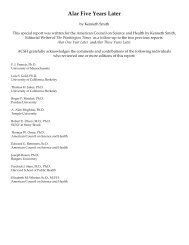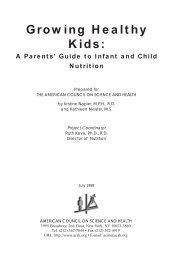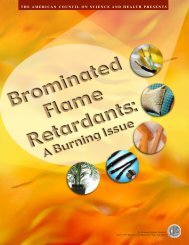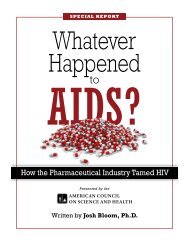The Role of Beef in the American Diet - International Meat Secretariat
The Role of Beef in the American Diet - International Meat Secretariat
The Role of Beef in the American Diet - International Meat Secretariat
Create successful ePaper yourself
Turn your PDF publications into a flip-book with our unique Google optimized e-Paper software.
<strong>The</strong> <strong>Role</strong> <strong>of</strong> <strong>Beef</strong> <strong>in</strong> <strong>the</strong> <strong>American</strong> <strong>Diet</strong><br />
26<br />
ganisms such as E. coli O157:H7 <strong>in</strong> meat has also been approved and is<br />
beg<strong>in</strong>n<strong>in</strong>g to be used for ground beef by some retailers (<strong>in</strong>clud<strong>in</strong>g<br />
Wegman’s, Dairy Queen, Omaha Steaks, and very recently, Giant — a<br />
major supermarket cha<strong>in</strong> <strong>in</strong> <strong>the</strong> Wash<strong>in</strong>gton, DC area). Irradiation is discussed<br />
<strong>in</strong> more detail below.<br />
Although all <strong>of</strong> <strong>the</strong>se steps are valuable, none <strong>of</strong> <strong>the</strong>m guarantees<br />
that ground beef will be free from E. coli O157:H7. Steam vacuum<strong>in</strong>g<br />
and similar technologies are not always 100% effective, and <strong>the</strong> fact<br />
that a sample from a particular batch <strong>of</strong> ground beef tested negative for<br />
<strong>the</strong> organism does not provide 100% assurance that o<strong>the</strong>r portions <strong>of</strong> <strong>the</strong><br />
same batch are not contam<strong>in</strong>ated. <strong>The</strong>refore, it is extremely important<br />
for consumers to protect <strong>the</strong>mselves by always cook<strong>in</strong>g ground beef to<br />
at least 160°F and prevent<strong>in</strong>g raw meat from cross-contam<strong>in</strong>at<strong>in</strong>g o<strong>the</strong>r<br />
foods.<br />
Salmonella<br />
<strong>The</strong> bacterium Salmonella is one <strong>of</strong> <strong>the</strong> lead<strong>in</strong>g causes <strong>of</strong> foodborne<br />
illness. It causes diarrhea, fever, and abdom<strong>in</strong>al cramps, usually last<strong>in</strong>g<br />
for 4–7 days (58). <strong>The</strong> disease, which is called salmonellosis, can be<br />
serious or even fatal <strong>in</strong> <strong>in</strong>fants, <strong>the</strong> elderly, and those with impaired<br />
immune systems, but it is usually not serious <strong>in</strong> o<strong>the</strong>r people.<br />
Salmonellosis is usually a foodborne disease, but it can also be spread<br />
by contact with pets or o<strong>the</strong>r animals, especially reptiles, and by personto-person<br />
contact. Fortunately, Salmonella bacteria <strong>in</strong> foods can be<br />
destroyed by cook<strong>in</strong>g.<br />
Salmonella is <strong>of</strong>ten found <strong>in</strong> raw meat and poultry — though less<br />
<strong>of</strong>ten <strong>in</strong> beef than <strong>in</strong> chicken or turkey. In recent U.S. Department <strong>of</strong><br />
Agriculture tests, Salmonella was found <strong>in</strong> 29.2% <strong>of</strong> ground turkey<br />
samples, 15.7% <strong>of</strong> ground chicken samples, and 3.4% <strong>of</strong> ground beef<br />
samples (59).<br />
<strong>The</strong> good news about Salmonella is that both <strong>the</strong> frequency <strong>of</strong> contam<strong>in</strong>ation<br />
<strong>of</strong> raw meat and poultry (59) and <strong>the</strong> number <strong>of</strong> cases <strong>of</strong> illness<br />
caused by this organism (60) have decreased substantially s<strong>in</strong>ce <strong>the</strong><br />
mid-1990s. <strong>The</strong>se decreases are believed to be l<strong>in</strong>ked to <strong>the</strong> implementation<br />
<strong>of</strong> improved science-based <strong>in</strong>spection and a systematic hazard<br />
control program called HACCP (for Hazard Analysis and Critical<br />
Control Po<strong>in</strong>ts) dur<strong>in</strong>g <strong>the</strong> same time period (59).<br />
Listeria monocytogenes<br />
Listeria monocytogenes is commonly found <strong>in</strong> <strong>the</strong> soil, on plants,<br />
and elsewhere <strong>in</strong> <strong>the</strong> environment. In most people, exposure to this bac-










